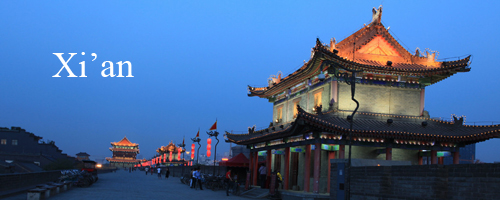Green spaces
We were immediately struck by how green it was everywhere, with parks and green spaces along the walls more or less on both sides all the way around.
Inside the wall was where the emperor lived, as Xi'an served as the capital during 13 dynasties, between the 11th century BC and the 10th century AD. Just around the city wall was the city wall garden and a city river, which was used as a defense of the city.
The Xi'an city wall is rectangular in shape. According to the stone tablets by the gates, it is 10-12 meters high, 12-14 meters wide at the top and 15-18 at the bottom, it stretches 4,256 meters from east to west and 2,078 from north to south, and has an outer perimeter of almost 14km. If you think it is grand today, imagine what it was like during the Tang Dynasty (AD 618-907), when the area enclosed by the city walls was apparently as much as seven times bigger.
The city wall as seen today was constructed on the foundations of the city walls from the Sui (AD 581-618) and Tang dynasties. Originally, when built between 1370 and 1378, under Ming Emperor Hongwu, the wall was made of rammed earth, with gates in all four directions. A brick construction was later raised under Ming Emperor Longqing, and when Emperor Chongzhen reigned, crescent fortifications, portcullis towers and the outer towns surrounding the gates in the south, north and west were added. Many improvements and restoration projects were carried out during the Qing Dynasty (1644-1911), and additions made that created the base for the pattern of the wall that we can see today.
In total, the Xi'an city wall has 18 gates, not all always available to the public, and 98 ramparts, one every 120 meters, extending from the wall to make it easier for soldiers to see and defend. In each corner of the wall there are watchtowers. The one in the southwestern different from the other three - which are all square - by virtue of being round.
Since 1961, the Xi'an city wall has been under state protection as a key cultural relic unit. During more recent years of restoration, in the 1980s, the government issued regulations that buildings inside the city wall must be built below the height of the wall, in order to protect the heritage and retain the flavor of the old, ancient city.
According to my boyfriend, one of the most fascinating things about the journey on the wall was "to see the old architecture on the one side and the new on the other, with the wall a natural part of the city landscape in the middle of it all."
The Silk Road
These days, according to a friend of mine from Xi'an, people who live just under the city wall are all very proud of it. Children grow up playing around it, and the city wall garden is where you can sense the real local life of Xi'an people. In the morning, they exercise in the gardens around the city wall, some practicing taichi, some playing diabolo or kongzhu in Chinese. You can also hear the authentic qinqiang, the local opera performed by Shaanxi people. It is also a good place for lovers to have a walk. "You can see the lichen after rainy days, and kind of sense the vitality of the ancient wall," my friend said.
Along the city walls there are several gates, with the main ones being Changle - or Eternal Joy - in the east, Anding - or Harmony Peace - in the west, Anyuan - or Forever Harmony - in the north and in the south, Yongning - or Eternal Peace. All the main gates have three towers, positioned to serve different purposes in defending.
The South Gate is the eastern starting and finishing point of the Silk Road, and hence the most beautifully decorated and famous one.
In ancient times Xi'an, or Chang'an, was the oriental cultural center of the Silk Road, and a vibrant and cosmopolitan city before any other in the Middle Kingdom.
These days, the South Gate square is often used by the provincial government for important official events and greetings, and there are regular performances, like the daily Gate Opening Ceremony, the Warrior Parade and acrobatics shows.
'Scottish' bar
Moving on westward along the southern part of the wall, we spotted a number of lovely rooftop terraces, made for lazy days in the sun.
After doing full circle and descending back down from the wall, with feet starting to ache and an urgent need for some food and drink, we climbed into a little tuk-tuk and returned to a place called Edinburgh - a charming cafe/bar on Shuncheng Xixiang, facing the wall.
Being certain they'd have menus in English, or at least pictures, at a "Scottish" bar was a mistake. However, we managed to order a couple of beers and some pistachios to get the blood sugar back up enough to find our way to nearby Defu Xiang, a street close to the South Gate, lined with restaurants and bars. Our favorite was Tribe, with a bit of an ethnic theme, relaxed atmosphere and decent music.
Another recommended area for food in Xi'an is the Muslim quarter, boasting delicious food and snacks to sample, just next to the Bell Tower Square. Mutton soup with bread, BBQ, small rice cakes - I could go on …
Special Coverage:

